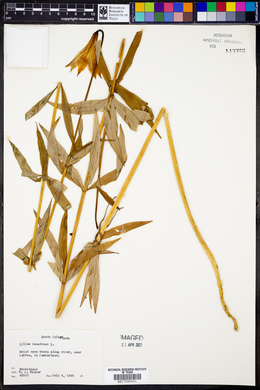Lilium canadense
|
|
|
|
Family: Liliaceae
Canadian Lily
|
Bulbs usually yellowish, rhizomatous, unbranched, 1.8-4.5 × 4.2-11.7 cm, 0.3-0.8 times taller than long, 2(-3) years´ growth evident as annual bulbs, scaleless sections between these 0.7-5.3 cm; scales 1-2-segmented, longest 0.9-2.8 cm; stem roots present, often very many. Stems to 1.8 m. Buds rounded in cross section. Leaves in 6-10 whorls or partial whorls, 3-12 leaves per whorl, ± horizontal, occasionally slightly ascending, drooping at tips, 4-17.3 × 1-3.6 cm, 2.5-10 times longer than wide; blade narrowly elliptic, occasionally elliptic or slightly lanceolate, margins not undulate, apex acute, often acuminate in distal leaves; principal veins impressed adaxially, veins and margins very noticeably roughened abaxially with small ± deltoid epidermal spicules. Inflorescences racemose, 1-17-flowered. Flowers pendent, not fragrant; perianth ± campanulate; sepals and petals somewhat recurved 1/2-3/4 along length from base, adaxial surface dirty yellow proximally and giving way to red dusting on tips, red or pale red abaxially, or orange adaxially and yellow-orange abaxially, or both surfaces solid yellow, spotted maroon, not distinctly clawed; sepals not ridged abaxially, 5.4-8.5 × 1.2-1.7 cm; petals 5.3-8 × 1.2-2 cm; stamens barely exserted; filaments ± parallel to style, barely spreading, diverging only 4°-6° from axis, ± same color as sepals and petals; anthers dull magenta or darker, 0.6-1.3 cm; pollen rust, sometimes light brown, rust-, tan-, or orange-brown; pistil 4.2-6.4 cm; ovary 1.5-2.8 cm; style ± same color as sepals and petals; pedicel 5-23.5 cm. Capsules 3-5.2 × 1.5-2.3 cm, 1.5-2.5 times longer than wide. Seeds not counted. 2n = 24. Flowering summer (Jun--early Aug). Wet meadows, moist rich woods especially edges, streamsides and river alluvia, bogs, marshes, swamps, along wet roadsides and railroads; 0--1000(--1400) m; N.B., N.S., Ont., Que.; Ala., Conn., Del., D.C., Ga., Ky., Maine, Md., Mass., N.H., N.J., N.Y., N.C., Ohio, Pa., R.I., S.C., Tenn., Vt., Va., W.Va. M. L. Fernald (1943e) proposed the variety editorum to account for the more montane plants with wide leaves (2-5 times longer than wide vs. 5-10 in var. canadense), red flowers with slender and elongate tubes with perianth parts arching near or above the middle but not recurved, and narrow petals (0.8-1.3 cm in dried material). Others, including E. T. Wherry (1946) and C. A. Best (1962), sought to characterize the variation better at the subspecific level, and placed more emphasis on ecological differences. In practice, most botanists who recognize var. editorum (e.g., R. M. Adams and W. J. Dress 1982) rely on flower color to designate the varieties, since other characters emerge as quite variable. Field observations do not strongly support infraspecific splitting of Lilium canadense. Flower color varies widely, and various color forms-usually yellow and orange-are found within single populations in Massachusetts and elsewhere. As interpreted by Adams and Dress, the distributions of the proposed varieties overlap widely, and morphological evidence also offers little support. Leaves 2-10 times longer than wide occur within a sample of plants from Ohio and Alabama that is clearly referable to subsp. editorum in the sense of Adams and Dress, and in these plants the floral tube is wider than that of Massachusetts plants assignable to the nominate variety. Petal widths (fresh material) are 1.2-2 cm. In short, the increasingly refined attempts of the last 60 years to suitably characterize variation in this species suggest that is quite difficult or impossible to do so. Though no specimens were seen, a report of Lilium canadense from Ashley County in extreme southeastern Arkansas is quite likely to represent L. superbum. Field observations across the range of the species indicate that the Canada lily is pollinated primarily by ruby-throated hummingbirds [Archilochus colubris (Linnaeus), family Trochilidae]. Native Americans used Lilium canadense medicinally to treat irregular menstruation, stomach disorders, rheumatism, and snake bites. The Cherokee prepared a decoction of boiled rhizomes to fatten children (D. E. Moerman 1986).
Stem slender, erect, 6-15 dm, smooth; lvs mostly in 6-11 whorls of 4-12, the lowest regularly and a few of the uppermost occasionally alternate; lf-blades lanceolate to linear-elliptic, widest at or below the middle, tapering to both ends, often spiculate-scabrous along the margins and veins beneath, the largest 8-15 cm נ8-20 mm; fls 1-5, nodding from long pedicels; tep narrowly oblanceolate, acuminate, only slightly or moderately recurved, 5-8 cm, yellow or orange-yellow, varying to sometimes nearly red, marked with purple spots within; filaments straight or nearly so, only the juxtaposed anthers evidently exserted; fl-bud subterete; 2n=24. Moist or wet meadows; Que. and Me. to Md. and in the mts. to Va., w. to O., Ky., s. Ind., and Ala. June-Aug. Gleason, Henry A. & Cronquist, Arthur J. 1991. Manual of vascular plants of northeastern United States and adjacent Canada. lxxv + 910 pp. ©The New York Botanical Garden. All rights reserved. Used by permission. From Flora of Indiana (1940) by Charles C. Deam This lily has been confused with the next [Lilium michiganense], and possibly all, or nearly all reports for it should be referred to the next species. All of my specimens are from rocky, wooded slopes and were associated with Vaccinium vacillans and Asclepias tuberosa. This species is now considered to be Alleghanian and its distribution is not known because of its confusion with the next species [L. michiganense]. .…… Indiana Coefficient of Conservatism: C = 7 Wetland Indicator Status: FAC |





































































